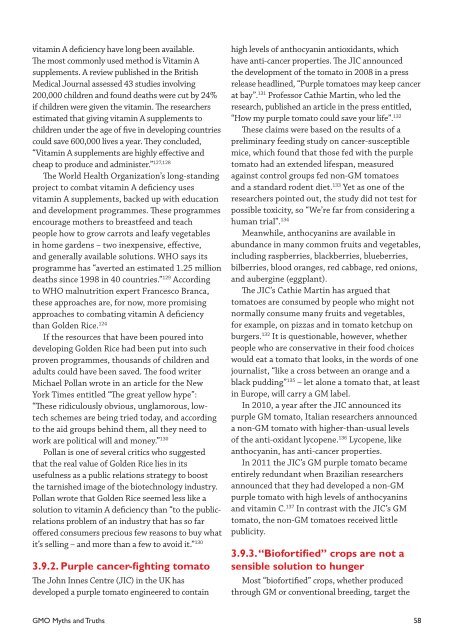GMO Myths and Truths
GMO Myths and Truths
GMO Myths and Truths
Create successful ePaper yourself
Turn your PDF publications into a flip-book with our unique Google optimized e-Paper software.
vitamin A deficiency have long been available.<br />
The most commonly used method is Vitamin A<br />
supplements. A review published in the British<br />
Medical Journal assessed 43 studies involving<br />
200,000 children <strong>and</strong> found deaths were cut by 24%<br />
if children were given the vitamin. The researchers<br />
estimated that giving vitamin A supplements to<br />
children under the age of five in developing countries<br />
could save 600,000 lives a year. They concluded,<br />
“Vitamin A supplements are highly effective <strong>and</strong><br />
cheap to produce <strong>and</strong> administer.” 127,128<br />
The World Health Organization’s long-st<strong>and</strong>ing<br />
project to combat vitamin A deficiency uses<br />
vitamin A supplements, backed up with education<br />
<strong>and</strong> development programmes. These programmes<br />
encourage mothers to breastfeed <strong>and</strong> teach<br />
people how to grow carrots <strong>and</strong> leafy vegetables<br />
in home gardens – two inexpensive, effective,<br />
<strong>and</strong> generally available solutions. WHO says its<br />
programme has “averted an estimated 1.25 million<br />
deaths since 1998 in 40 countries.” 129 According<br />
to WHO malnutrition expert Francesco Branca,<br />
these approaches are, for now, more promising<br />
approaches to combating vitamin A deficiency<br />
than Golden Rice. 124<br />
If the resources that have been poured into<br />
developing Golden Rice had been put into such<br />
proven programmes, thous<strong>and</strong>s of children <strong>and</strong><br />
adults could have been saved. The food writer<br />
Michael Pollan wrote in an article for the New<br />
York Times entitled “The great yellow hype”:<br />
“These ridiculously obvious, unglamorous, lowtech<br />
schemes are being tried today, <strong>and</strong> according<br />
to the aid groups behind them, all they need to<br />
work are political will <strong>and</strong> money.” 130<br />
Pollan is one of several critics who suggested<br />
that the real value of Golden Rice lies in its<br />
usefulness as a public relations strategy to boost<br />
the tarnished image of the biotechnology industry.<br />
Pollan wrote that Golden Rice seemed less like a<br />
solution to vitamin A deficiency than “to the publicrelations<br />
problem of an industry that has so far<br />
offered consumers precious few reasons to buy what<br />
it’s selling – <strong>and</strong> more than a few to avoid it.” 130<br />
3.9.2. Purple cancer-fighting tomato<br />
The John Innes Centre (JIC) in the UK has<br />
developed a purple tomato engineered to contain<br />
high levels of anthocyanin antioxidants, which<br />
have anti-cancer properties. The JIC announced<br />
the development of the tomato in 2008 in a press<br />
release headlined, “Purple tomatoes may keep cancer<br />
at bay”. 131 Professor Cathie Martin, who led the<br />
research, published an article in the press entitled,<br />
“How my purple tomato could save your life”. 132<br />
These claims were based on the results of a<br />
preliminary feeding study on cancer-susceptible<br />
mice, which found that those fed with the purple<br />
tomato had an extended lifespan, measured<br />
against control groups fed non-GM tomatoes<br />
<strong>and</strong> a st<strong>and</strong>ard rodent diet. 133 Yet as one of the<br />
researchers pointed out, the study did not test for<br />
possible toxicity, so “We’re far from considering a<br />
human trial”. 134<br />
Meanwhile, anthocyanins are available in<br />
abundance in many common fruits <strong>and</strong> vegetables,<br />
including raspberries, blackberries, blueberries,<br />
bilberries, blood oranges, red cabbage, red onions,<br />
<strong>and</strong> aubergine (eggplant).<br />
The JIC’s Cathie Martin has argued that<br />
tomatoes are consumed by people who might not<br />
normally consume many fruits <strong>and</strong> vegetables,<br />
for example, on pizzas <strong>and</strong> in tomato ketchup on<br />
burgers. 132 It is questionable, however, whether<br />
people who are conservative in their food choices<br />
would eat a tomato that looks, in the words of one<br />
journalist, “like a cross between an orange <strong>and</strong> a<br />
black pudding” 135 – let alone a tomato that, at least<br />
in Europe, will carry a GM label.<br />
In 2010, a year after the JIC announced its<br />
purple GM tomato, Italian researchers announced<br />
a non-GM tomato with higher-than-usual levels<br />
of the anti-oxidant lycopene. 136 Lycopene, like<br />
anthocyanin, has anti-cancer properties.<br />
In 2011 the JIC’s GM purple tomato became<br />
entirely redundant when Brazilian researchers<br />
announced that they had developed a non-GM<br />
purple tomato with high levels of anthocyanins<br />
<strong>and</strong> vitamin C. 137 In contrast with the JIC’s GM<br />
tomato, the non-GM tomatoes received little<br />
publicity.<br />
3.9.3. “Biofortified” crops are not a<br />
sensible solution to hunger<br />
Most “biofortified” crops, whether produced<br />
through GM or conventional breeding, target the<br />
<strong>GMO</strong> <strong>Myths</strong> <strong>and</strong> <strong>Truths</strong> 58


